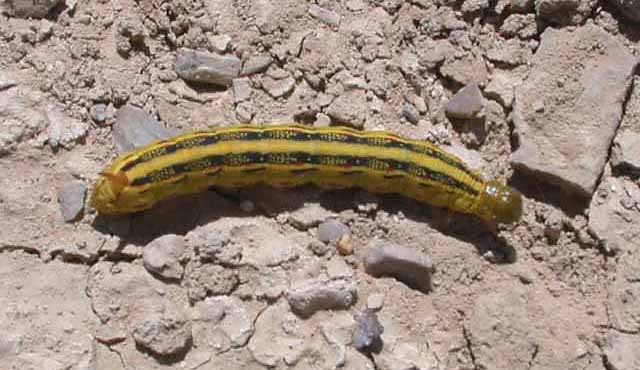Sphinginae subfamily
Sphingini tribe:
 |
This species has not been reported in Wayne County, but may be there
as a stray. The moth is a very strong flier and is frequently
encountered far north of its usual range.
|
 |
This large bodied moth flies in tobacco fields and vegetable gardens
(potatoes, tomatoes) and wherever host plants are found. I suspect it is in Wayne County. |
 |
This species is not recorded in Wayne County, and would be unlikely.
If you grow tomatoes, however, you have may have encountered it.
Larvae get very large and can strip a tomato plant. |
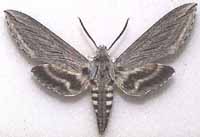 |
This species is not recorded in Wayne County, and would be unlikely.
It flies in pinyon-juniper woodland and similar arid situations in
Colorado (specimen type locality) and Nevada, Utah,
Arizona and New Mexico. |
 |
Sphinx chersis
WO, the Northern Ash
Sphinx or Great Ash Sphinx
The upperside of the forewing is soft dark-gray to blue-gray with
a series of black dashes, one reaching the wing tip. Note grey
thorax with narrow black lines.
|
 |
This species is not reported for Wayne County.
I only see them only occasionally on P.E.I. despite visiting lights frequently. |
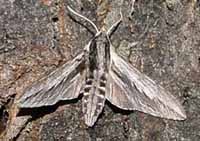 |
This species is not reported for Wayne County but may be present.
It flies in arid brushlands and desert foothills. |
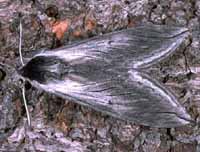 |
Sphinx perelegans adults fly in montane woodlands and mixed chaparral-type vegetation as a single brood
in the north, with adults mainly on the wing in June and July.
It flies from dusk until after midnight. Note dark thorax. |
 |
Sphinx vashti
USGS, the Snowberry Sphinx,
Snowberry Sphinx adults fly as a single brood in montane woodlands and along prairie
streamcourses from April to August, usually further
north.
The upperside of the forewing has a narrow black subterminal line
bordered by a white inverted V-shaped line on the outside, and a
black line at the apex. |
Smerinthini Tribe:
 |
Pachysphinx modesta WO,
the Modest Sphinx or Poplar Sphinx,
This large poplar/willow feeder is possibly in Wayne County.
They are a heavy bodied species.
|
 |
This one is quite similar to Pachysphinx modesta, with modesta
being smaller and darker.
Moths should be on the wing from June-August.
|
 |
The grey-blue eyespot of the hindwing gives this species its name.
Larvae feed on birches, willows, cherries and oaks.
The outer edge of the forewings is quite scalloped. |
 |
This small species is probably probably present as it
ranges across North America.
The hindwings have a small blue eyespot ringed with black on a yellow background.
|
 |
Smerinthus cerisyi
USGS, the Cerisyi's
Sphinx or One-eyed Sphinx, Larvae feed on poplars and willows.
Flight would be from late May-July as a single brood.
|
Macroglossinae subfamily
Dilophonotini Tribe:
 |
Hemaris diffinis
WO,
the Snowberry Clearwing or Bumblebee Moth,
The moth flies along forest edges and in meadows, gardens and
brushy fields. Day-flying adults nectar at lantana, dwarf bush honeysuckle,
snowberry, orange hawkweed, thistles, lilac, Canada violet, etc. |
 |
Hemaris senta
WO,
the Rocky Mountain Clearwing,
There is probably a single brood of this montane species from
May-August. The moth is seen along streamsides and in meadows in
mountainous areas. |
Philampelini Tribe:
 |
This moth is not recorded for Wayne County,
but it may be present wherever grapes are found.
Fight would be from June to August. Larvae feed on grape foliage. |
Macroglossini Tribe:
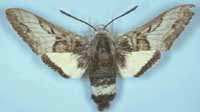 |
Euproserpinus wiesti adults fly, during the day, over sand washes
and prairie
blow-outs as a single brood from May-June.
|
 |
Hyles lineata
FE,
the White-lined Sphinx
Adults usually fly at dusk, during the night, at dawn, and during the
day. Moths nectar at salvia and oviposit on a number of different
plants. It is confirmed for Wayne County by Frank Erickson.
|
|
|
